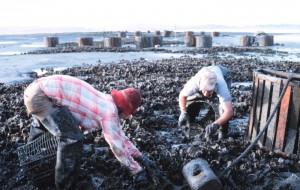16
Oyster Farming Talk Gaining Momentum in Chesapeake Bay
More than 90 percent of oysters landed around the world are the result of some sort of oyster farming, according to marine scientists. But that is not the case in Maryland , where aquaculture never really caught on despite a dramatic decline in the oyster population.
That could change soon. State officials are promoting some new oyster farming proposals, ideas which could gain popularity in the wake of recent good news about Maryland’s blue crab. On April 14, Gov. Martin O’Malley announced that blue crabs are on the rise, thanks to harvest restrictions that helped boost the adult female crab population.
Now the Maryland Department of Natural Resources aims to help spark a similar revival in the oyster population, through a proposal it calls the Oyster Restoration and Aquaculture Development Plan. Released in December 2009, the plans calls for expanding the number of no-harvest zones that would be off limits to oystering, and increasing the areas available for leasing to private oyster farming operations in the Chesapeake Bay.
If the plan to encourage oyster farming is successful, it would bring Maryland’s oyster management “efforts more in line with virtually all other regions in the world,” according to University of Maryland marine biologists Victor Kennedy and Roger Newell.
In a recent article, Kenney and Newell noted that the problem dwindling oysters has been the subject of political discussion for three centuries:
“In 1701, a Swiss visitor reported that Chesapeake oysters were so abundant that ships sometimes ran aground on oyster reefs, and so large that they had to be cut in two to be eaten. Over time, Maryland’s oyster industry grew until the landings in the 1880s were twice those of the rest of the world combined. However, about that time annual harvests began to decline, causing much consternation.
An Oyster Commission formed in 1882 to study the problem linked the harvest decline to overfishing, diminishing amounts of settlement material (shell) and destruction of oyster spat by harvest practices. Among other recommendations, the commission called for a reliance on trained experts — not politicians — to close oyster beds where and when necessary to allow for rehabilitation. It also recommended a system of private oyster farming on bottoms leased from the state to supplement the public fishery.
Unfortunately, there was no political will to implement these two conservation measures. These recommendations (and similar recommendations by a number of later commissions) were not followed, and more than a century later this same debate is again taking place in Annapolis.”
Maryland already runs a volunteer program that encourages individuals to grow baby oysters and deposit them in the bay, for which it maintains a “guide to growing oysters” page on a state government Web site. But the move into commercial aquaculture represents a bigger shift and likely will take more than individual initiative from citizens.
Maryland politicians have reached no consensus yet on what kind of oyster farming would be best for reviving the Chesapeake bivalve. But since it is an election year, with the governorship and all 188 seats in the General Assembly at stake, the debate should be interesting to watch.
About Us
Our Stories
- Md. Officials May Temporarily Lift Ban on Female Crab Harvest in Bay
- Scientists, Environmentalists Question Readiness of Chesapeake Bay Disaster Plans
- Inner Harbor Water: Unsafe Bacteria Levels, Test Shows
- Swimmers’ Impressions of Bay Not Always in Sync With Its Health, Scientists Say
- Chesapeake Bay Swim Attracts Hundreds in Balmy Conditions, But Course Includes ‘Dead Zone’
















